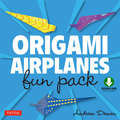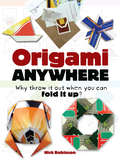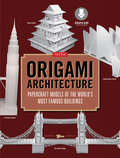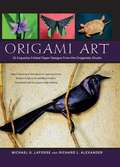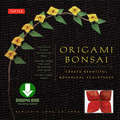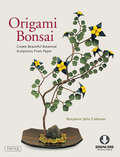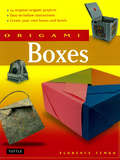- Table View
- List View
Origami Airplanes Fun Pack
by Andrew DewarStart folding paper airplanes right away with this easy origami ebook.Origami Airplanes Fun Pack presents a collection of realistic origami paper airplanes from well-known author and paper aviation expert Andrew Dewar.<P><P> Dewar has spent decades perfecting the art of folding easy paper airplanes that both look great and fly well. Origami Airplanes Fun Pack features a selection of the easiest-to-fold and best-flying paper airplanes.All the origami projects are designed to be simple enough to be considered "origami-for-kids" kits, and can be assembled by beginning origami folders. Paper airplanes are a great way for children to learn origami and gain an interest and appreciation for this fascinating art form. The flashy folding papers already have plane images printed on them, making the finished origami planes look as awesome as they fly. Folding lines are printed right on the paper so there is no need to make precise measurements. Just unpack, and start folding immediately.This origami ebook contains: Full-colored origami assembly book Step-by-step instructions and diagrams 6 original design projects for planesFun and accessible for both the paper crafts novice and the more season paper folder, this wonderfully giftable origami ebook gets you started right away and is a great value. The pre-colored origami paper is ready to fold-No scissors or glue required!Origami airplane projects include: Alpha Jet Spectre Phoenix Diamond Dart Soarer Star Clipper
Origami Animals
by Michael G. LafosseKids love animals and in this book they will learn how to make origami butterflies, bats, cats, and even a mother and baby duck in a project that celebrates springtime. Fascinating facts about each animal complement the origami projects, making this a book that celebrates both art and science.
Origami Animals
by Michael G. LafosseMake colorful and fun origami animals with this easy origami ebook. Fogs, butterflies, seals and dogs are just a few of the gorgeous origami animals you can create with this paper craft origami ebook. From world renowned origami artist, Michael LaFosse, comes this essential collection of animal paper craft projects. Perfect for folders of all skill level, Origami Animals is the affordable easy-to-follow solution for everything needed to get started on traditional animal origami designs as well as new twists on old favorites. This unique collection of origami designs will help you create folded paper models of animals from around the world. Use it to craft eye-catching origami for your friends, to beautify your home-or as a wonderful gift for animal lovers. All of the folds are simple enough to be origami-for-kids projects and are a great way to learn origami. The origami kit contains: Full-colored 64-page booklet Clear, step-by-step diagrams and instructions 45 fun origami projects Origami Animals provides you this stunning collection of origami projects that will have you creating your own personal zoo in no time! Origami animal projects include: Cobra Elephant Head Jumping Frog Horeshoe Crab Dinosaur Husky Pup Crane And many more...
Origami Animals
by Michael G. LafosseMake colorful and fun origami animals with this easy origami ebook.Fogs, butterflies, seals and dogs are just a few of the gorgeous origami animals you can create with this paper craft origami ebook. From world renowned origami artist, Michael LaFosse, comes this essential collection of animal paper craft projects. Perfect for folders of all skill level, Origami Animals is the affordable easy-to-follow solution for everything needed to get started on traditional animal origami designs as well as new twists on old favorites. This unique collection of origami designs will help you create folded paper models of animals from around the world. Use it to craft eye-catching origami for your friends, to beautify your home-or as a wonderful gift for animal lovers.All of the folds are simple enough to be origami-for-kids projects and are a great way to learn origami.The origami kit contains: Full-colored 64-page booklet Clear, step-by-step diagrams and instructions 45 fun origami projectsOrigami Animals provides you this stunning collection of origami projects that will have you creating your own personal zoo in no time!Origami animal projects include: Cobra Elephant Head Jumping Frog Horeshoe Crab Dinosaur Husky Pup Crane And many more...
Origami Animals (Dover Crafts: Origami & Papercrafts)
by Vicente PalaciosOrigami enthusiasts at all levels of experience will delight in these imaginative animals. Created by expert paperfolder Vicente Palacios, the simple but detailed folding instructions include helpful two-color illustrations of each step. Twenty charming creatures range from simple versions of a swan, rabbit, and dog to more complex models of a fox, elephant, and frog. Other whimsical figures include a goose, hippo, bear, camel, and dragon — a splendid menagerie that will enrich any origamist's repertoire.
Origami Anywhere: Why Throw It Out When You Can Fold It Up?
by Nick Robinson"This is a superb book with lots of different designs to have a go at making. The instructions are easily followed and there are a wide range of different designs. I highly recommend this to anyone interested in origami as it is relatively easy to follow and uses recycled materials rather than expensive origami papers. On top of all that it is great fun!" -- Splashes Into Books"A delightful book that features a number of enchanting projects to teach you how to do origami." --Erisea Mag"One man's trash is another man's treasure" was never truer! With this remarkable book, you can recycle throwaways into origami art. Twenty-nine well-illustrated projects explain how to make an autumn leaf from a lotto ticket, a 3-D heart from aluminum foil, a flower from a tea bag wrapper, and other unusual keepsakes and charming gifts. Each item includes a brief introduction with suggestions for the paper's color and texture, and every step of the numbered instructions features simple text accompanied by a clear diagram. You'll discover how to transform brown wrapping paper into a fox, a supermarket receipt into a dachshund, and other ordinary bits of paper into an arrowhead, jumping frog, pill box, rocking cradle, koala, and other treasures.
Origami Aquarium
by Michael G. LafosseMake colorful and fun origami fish and sea creatures with this easy origami kit. Sharks, fish and turtles are just a few of the origami ocean creatures you can create with this paper craft origami kit. World renowned origami artist Michael LaFosse introduces 20 unique origami paper craft designs for exotic undersea creatures. People of all ages and any level of skill, will enjoy crafting these eye-catching origami. This unique collection of origami designs will help you create folded paper models of fish and other animals from around the world. Finished origami projects are great for friends, to decorate your room, or for kids fascinated by aquariums and aquatic creatures. All of the folds are simple enough to be origami-for-kids projects and are a great way to learn origami. The origami paper in the kit already has printed colors so no paint or glue is required, just unpack and start folding right away! The origami kit contains: 2 full-colored, 32-page booklets Clear step-by-step instructions Easy-to-follow diagrams 20 simple origami projects 96 sheets of durable authentic origami folding paper A variety of different colors and patterns Origami Aquarium Kit provides you this stunning collection of origami projects that will have you creating your own personal aquarium in no time! Origami projects include: Shark Whale Seal Horseshoe Crab Seahorse And many more. . .
Origami Aquarium
by Michael G. LafosseMake colorful and fun origami fish and sea creatures with this easy origami ebook.Sharks, fish and turtles are just a few of the origami ocean creatures you can create with this paper craft origami ebook.<P><P> World renowned origami artist Michael LaFosse introduces 20 unique origami paper craft designs for exotic undersea creatures. People of all ages and any level of skill, will enjoy crafting these eye-catching origami. This unique collection of origami designs will help you create folded paper models of fish and other animals from around the world. Finished origami projects are great for friends, to decorate your room, or for kids fascinated by aquariums and aquatic creatures.All of the folds are simple enough to be origami-for-kids projects and are a great way to learn origami. The origami kit contains: 2 full-colored, 32-page booklets Clear step-by-step instructions Easy-to-follow diagrams 20 simple origami projectsOrigami Aquarium provides you this stunning collection of origami projects that will have you creating your own personal aquarium in no time!Origami projects include: Shark Whale Seal Horseshoe Crab Seahorse And many more...
Origami Architecture
by Artist YeeThe incredible splendors of some of the worlds' most recognized architectural feats are brought to life within the pages of Origami Architecture. With this paper craft book, some card stock paper, and a hobby knife, anyone can build spectacular re-creation's of the most famous buildings in the world.There are over 900 photographs detailing the cutting and assembling of the pieces, most without using glue or tape. Once the structure is attached to the base not only will does it look amazing, but it can be folded up and taken anywhere. For the would-be architect, the papercraft hobbyist, or a model builder, Origami Architecture will provide hours of activity with impressive results. This comes with a full-color instructional booklet, downloadable material and brief history lessons for each buildingsProjects include:Arc de TriompheLeaning Tower of PisaHall of Supreme HarmonyWhite HouseNational Centre for the Performing Arts ChinaSydney Opera HouseEiffel TowerOsaka CastlePetronas TowersWestminster AbbeyTower BridgeUnited States CapitolChrysler BuildingAthens ParthenonLincoln MemorialPalace of Westminster
Origami Architecture
by Sheung Yee ShingBuild detailed and impressive models of world landmarks with this beautiful origami book. The incredible splendors of some of the worlds' most recognized architectural feats are brought to life within the pages of Origami Architecture. With this paper craft book, some card stock paper, and a hobby knife, anyone can build spectacular re-creation's of the most famous buildings in the world. Based on the extraordinary models of world-renowned papercrafter, and origami artist Yee, whose own remarkable origami recreations of these very same models sell for thousands of dollars, these paper replicas are nearly as impressive as the original buildings. Yee provides detailed instructions on how to cut and assemble these architectural landmarks from around the world. Yee even engineered half of these designs so they could be assembled without having to use glue. The origami projects have a range of difficulty levels, from the relatively easy (Arc d'Triomphe) to the impressively sophisticated and intricate (The Tower Bridge). Once the structure is attached to the base not only will does it look amazing, but it can be folded up and taken anywhere. This origami book includes: Over 900 photographs Full-color instructional assembly diagrams Brief histories of each building Downloadable CD content
Origami Architecture
by YeeBuild detailed and impressive models of world landmarks with this beautiful origami book. The incredible splendors of some of the worlds' most recognized architectural feats are brought to life within the pages of Origami Architecture. With this paper craft book, some card stock paper, and a hobby knife, anyone can build spectacular re-creation's of the most famous buildings in the world. Based on the extraordinary models of world-renowned papercrafter, and origami artist Yee, whose own remarkable origami recreations of these very same models sell for thousands of dollars, these paper replicas are nearly as impressive as the original buildings. Yee provides detailed instructions on how to cut and assemble these architectural landmarks from around the world. Yee even engineered half of these designs so they could be assembled without having to use glue. The origami projects have a range of difficulty levels, from the relatively easy (Arc d'Triomphe) to the impressively sophisticated and intricate (The Tower Bridge). Once the structure is attached to the base not only will does it look amazing, but it can be folded up and taken anywhere. This origami book includes: Over 900 photographs Full-color instructional assembly diagrams Brief histories of each building CD with detailed templates For the would-be architect, the paper craft hobbyist, or a model builder, Origami Architecture will provide hours of activity with impressive results. Origami projects include: Arc de Triomphe Leaning Tower of Pisa Hall of Supreme Harmony White House National Centre for the Performing Arts China Sydney Opera House Eiffel Tower And many more. . .
Origami Art
by Richard L. Alexander Michael G. LafosseOrigami Art is a unique new collection of origami projects featuring folding instructions for 15 complex origami models. Intricate, compelling and often lifelike, LaFosse's origami projects amaze and astound. Included here are such wonders as the American Alligator, Pond Turtles, Monk Seal, Malaysian Birdwing Butterfly and the Munich Orchid, among others.Also featured are articles on paper selection and preparation for each project; advanced techniques, such as "wetfolding" and compound origami plant design and construction. LaFosse embraces every aspect of this fascinating art form in his newest book and presents it brilliantly for advanced paper folders and the artist in us all.
Origami Art
by Richard L. Alexander Michael G. LafosseOrigami Art is a unique new collection of origami projects featuring folding instructions for 15 complex origami models. Intricate, compelling and often lifelike, LaFosse's origami projects amaze and astound. Included here are such wonders as the American Alligator, Pond Turtles, Monk Seal, Malaysian Birdwing Butterfly and the Munich Orchid, among others.Also featured are articles on paper selection and preparation for each project; advanced techniques, such as "wetfolding" and compound origami plant design and construction. LaFosse embraces every aspect of this fascinating art form in his newest book and presents it brilliantly for advanced paper folders and the artist in us all.
Origami Birds
by Michael G. LafosseMake colorful and fun origami birds with this easy origami kit. Cranes, swans and macaws are just a few of the gorgeous birds you can create with this paper craft origami kit. World renowned origami artist Michael LaFosse introduces Origami Birds Kit with craft projects for the beginner or the intermediate paper folder looking to expand their repertoire. This unique collection of origami designs will help you create folded paper models of common and exotic birds from around the world. Use it to craft eye-catching origami for your friends, to beautify your home-or as a wonderful gift for bird lovers. All of the folds are simple enough to be origami-for-kids projects and are a great way to learn origami. The origami paper in the kit already has printed patters so no paint or glue is required, just unpack and start folding right away! The origami kit contains: 2 full-colored, 32-page booklets Clear step-by-step instructions Easy-to-follow diagrams 20 simple origami bird projects 98 sheets of durable authentic origami folding paper A variety of different colors and patterns Origami Birds Kit provides you this stunning collection of origami projects that will have you creating your own personal aviary in no time! Origami projects include: Crane Swallow Cardinal Phoenix Macaw And many more. . .
Origami Birds
by Michael G. LafosseMake colorful and fun origami birds with this easy origami ebook. Cranes, swans and macaws are just a few of the gorgeous birds you can create with this paper craft origami ebook. World renowned origami artist Michael LaFosse introduces Origami Birds with craft projects for the beginner or the intermediate paper folder looking to expand their repertoire. This unique collection of origami designs will help you create folded paper models of common and exotic birds from around the world. Use it to craft eye-catching origami for your friends, to beautify your home-or as a wonderful gift for bird lovers. All of the folds are simple enough to be origami-for-kids projects and are a great way to learn origami. The origami ebook contains: 2 full-colored, 32-page booklets Clear step-by-step instructions Easy-to-follow diagrams 20 simple origami bird projects Origami Birds provides you this stunning collection of origami projects that will have you creating your own personal aviary in no time! Origami projects include: Crane Swallow Cardinal Phoenix Macaw And many more...
Origami Birds
by Michael G. LafosseMake colorful and fun origami birds with this easy origami ebook.Cranes, swans and macaws are just a few of the gorgeous birds you can create with this paper craft origami ebook. World renowned origami artist Michael LaFosse introduces Origami Birds with craft projects for the beginner or the intermediate paper folder looking to expand their repertoire. This unique collection of origami designs will help you create folded paper models of common and exotic birds from around the world. Use it to craft eye-catching origami for your friends, to beautify your home-or as a wonderful gift for bird lovers.All of the folds are simple enough to be origami-for-kids projects and are a great way to learn origami.The origami ebook contains: 2 full-colored, 32-page booklets Clear step-by-step instructions Easy-to-follow diagrams 20 simple origami bird projectsOrigami Birds provides you this stunning collection of origami projects that will have you creating your own personal aviary in no time!Origami projects include: Crane Swallow Cardinal Phoenix Macaw And many more...
Origami Birds Kit: (Downloadable Material Included)
by Michael G. LafosseMake colorful and fun origami birds with this easy origami ebook.Cranes, swans and macaws are just a few of the gorgeous birds you can create with this paper craft origami ebook. World renowned origami artist Michael LaFosse introduces Origami Birds with craft projects for the beginner or the intermediate paper folder looking to expand their repertoire. This unique collection of origami designs will help you create folded paper models of common and exotic birds from around the world. Use it to craft eye-catching origami for your friends, to beautify your home-or as a wonderful gift for bird lovers.All of the folds are simple enough to be origami-for-kids projects and are a great way to learn origami. The origami paper already has printed patters so no paint or glue is required, just unpack and start folding right away!The origami ebook contains: 2 full-colored, 32-page booklets Clear step-by-step instructions Easy-to-follow diagrams 20 simple origami bird projects 98 sheets of origami folding paper A variety of different colors and patternsOrigami Birds provides you this stunning collection of origami projects that will have you creating your own personal aviary in no time!Origami projects include: Crane Swallow Cardinal Phoenix Macaw And many more...
Origami Bonsai
by Benjamin John ColemanMake beautiful origami flowers then arrange them into stunning origami bonsai sculptures with this easy origami kit. By merging two iconic Japanese art forms-origami and bonsai-Benjamin Coleman sparked an exciting evolution in paper folding, and made a name for himself in both the origami world and on the Etsy landscape. Now, Origami Bonsai Kit makes it possible for paper folders at every level to create Coleman's unique botanical sculptures at home by folding delicate paper flowers and leaves and attaching them to natural branches. Coleman uses the innovative origami "glow-fold" method and utilizes color to identify exactly which part of the model to fold in any given step making it easy for beginning origami folders to create exquisite bonsai paper art. In addition to sharing his revolutionary paper crafting techniques, Coleman also shows you how to select natural twigs, branches, and stones-and how to assemble them into a lifelike finished origami sculpture. This easy origami kit contains: Full-color 64-page instruction book Step-by-step instructions Introduction to paper folding techniques 8 different mix-and-match flower forms 4 different types of leaves Origami folding paper for 400 flowers and leaves A 3 hour instructional DVD Folding paper flowers is a great way for beginners to learn origami while still making an impressive finished bonsai sculpture. Even experienced folders will find new and original designs to add to their origami repertoires! Origami flower projects include: The Ficus Leaf The Berlin Poplar Leaf The Black Eyed Susan The Foxglove The Buttercup And many more. . .
Origami Bonsai
by Benjamin John ColemanMake beautiful origami flowers then arrange them into stunning bonsai sculptures with this wonderful origami book. By merging two iconic Japanese art forms—origami and bonsai—Benjamin Coleman sparked an exciting evolution in paper folding, and made a name for himself in both the origami world and on the Etsy landscape. In addition to sharing his revolutionary paper crafting techniques, Coleman also shows you how to select natural twigs, branches, and stones—and how to assemble them into a lifelike finished origami sculpture. To help in the creation process the book contains detailed instructions and numerous photographs of both works in process and completed origami bonsai pieces that are sure to have you crating your own decorative origami art in no time. This easy origami book contains: Beautiful, multi-color photos and drawings Step-by-step instructions Explanations of dozens of folding techniques 3 hours of downloadable video Folding paper flowers is a great way for beginners to learn origami while still making an impressive finished bonsai sculpture. Even experienced folders will find new and original designs to add to their origami repertoires! Origami flower projects include: The Ficus Leaf The Berlin Poplar Leaf The Black Eyed Susan The Foxglove The Buttercup And many more. . .
Origami Bonsai
by Benjamin John ColemanMake beautiful origami flowers then arrange them into stunning origami bonsai sculptures with this easy origami ebook. By merging two iconic Japanese art forms-origami and bonsai-Benjamin Coleman sparked an exciting evolution in paper folding, and made a name for himself in both the origami world and on the Etsy landscape. Now, Origami Bonsai makes it possible for paper folders at every level to create Coleman's unique botanical sculptures at home by folding delicate paper flowers and leaves and attaching them to natural branches. Coleman uses the innovative origami "glow-fold" method and utilizes color to identify exactly which part of the model to fold in any given step making it easy for beginning origami folders to create exquisite bonsai paper art. In addition to sharing his revolutionary paper crafting techniques, Coleman also shows you how to select natural twigs, branches, and stones-and how to assemble them into a lifelike finished origami sculpture. This easy origami ebook contains: Full-color 64-page instruction book Step-by-step instructions Introduction to paper folding techniques 8 different mix-and-match flower forms 4 different types of leaves Downloadable instructions Folding paper flowers is a great way for beginners to learn origami while still making an impressive finished bonsai sculpture. Even experienced folders will find new and original designs to add to their origami repertoires! Origami flower projects include: The Ficus Leaf The Berlin Poplar Leaf The Black Eyed Susan The Foxglove The Buttercup And many more...
Origami Bonsai
by Benjamin John ColemanOrigami bonsai is the art of folding paper flowers and leaves which are glued to natural branches, creating exquisite botanical sculptures. Origami Bonsai teaches readers from all walks of life the skills necessary to create these intricate and stunning pieces of art.The beauty of origami bonsai is that even newcomers to paperfolding can create fantastic arrangements. With each page of the book readers will have the opportunity to create their own amazingly lifelike sculptures. Revolutionary approaches in this book include mass production of leaves, painting techniques and depth enhancement. Each page leads to new discoveries that will inspire the creation of wildly complex plant sculptures. Readers will be surprised at how easy these sculptures are to create, and how much they are appreciated by others.
Origami Bonsai
by Benjamin John ColemanMake beautiful origami flowers then arrange them into stunning origami bonsai sculptures with this easy origami ebook.By merging two iconic Japanese art forms-origami and bonsai-Benjamin Coleman sparked an exciting evolution in paper folding, and made a name for himself in both the origami world and on the Etsy landscape. Now, Origami Bonsai makes it possible for paper folders at every level to create Coleman's unique botanical sculptures at home by folding delicate paper flowers and leaves and attaching them to natural branches.Coleman uses the innovative origami "glow-fold" method and utilizes color to identify exactly which part of the model to fold in any given step making it easy for beginning origami folders to create exquisite bonsai paper art. In addition to sharing his revolutionary paper crafting techniques, Coleman also shows you how to select natural twigs, branches, and stones-and how to assemble them into a lifelike finished origami sculpture.This easy origami ebook contains: Full-color 64-page instruction book Step-by-step instructions Introduction to paper folding techniques 8 different mix-and-match flower forms 4 different types of leaves Downloadable instructionsFolding paper flowers is a great way for beginners to learn origami while still making an impressive finished bonsai sculpture. Even experienced folders will find new and original designs to add to their origami repertoires!Origami flower projects include: The Ficus Leaf The Berlin Poplar Leaf The Black Eyed Susan The Foxglove The Buttercup And many more...
Origami Boxes
by Florence TemkoOrigami is the ideal craft for anyone who likes to create with their hands. The projects in this book can help you express your creativity by folding wonderful containers out of single sheets of paper, perfect for gift-giving or display around the house. Origami Boxesfeatures designs for 24 boxes that range from traditional to unique, including a Row of Boxes, Round Bowl, and Triangle Gift Box created by origami expert Florence Temko.Each box is explained with easy to follow diagrams and illustrated with a photograph of the finished project. A section on folding techniques makes it easy to get started, with special tips on how to adapt boxes to different sizes and papers. This book is sure to provide hours of entertainment for both children and adults.
Origami Boxes
by Florence TemkoOrigami is the ideal craft for anyone who likes to create with their hands. The projects in this book can help you express your creativity by folding wonderful containers out of single sheets of paper, perfect for gift-giving or display around the house. Origami Boxesfeatures designs for 24 boxes that range from traditional to unique, including a Row of Boxes, Round Bowl, and Triangle Gift Box created by origami expert Florence Temko.Each box is explained with easy to follow diagrams and illustrated with a photograph of the finished project. A section on folding techniques makes it easy to get started, with special tips on how to adapt boxes to different sizes and papers. This book is sure to provide hours of entertainment for both children and adults.
Origami Bugs
by Michael G. LafosseMake simple and fun origami insects with this easy paper craft kit. Ants, dragonflies, tarantulas are just a few of the creepy, crawly creatures you can create with friendly origami kit. World renowned origami artist Michael LaFosse introduces this paper craft kit that kids and paper folders of all ages will love-turning brightly colored sheets of origami paper into 20 different insects and arachnids. Use it to craft eye-catching origami for your friends, to decorate your room-or as a wonderful gift for insects lovers. All of the folds are simple enough to be origami-for-kids projects and are a great way to learn origami. The origami paper in the kit already has printed patters so no paint or glue is required, just unpack and start folding right away! This origami kit contains: 2 full-colored, 32-page booklets Clear step-by-step instructions Easy-to-follow diagrams 20 simple origami insect projects 96 sheets of durable authentic origami folding paper A variety of different colors and patterns 2 sheets of gold foil Origami Bugs Kit provides you this stunning collection of origami projects that will have you folding your own insect zoo in no time! Origami projects include: Butterfly Caterpillar Firefly Grasshopper Ant And many more. . .
